|
|
St Ephraim, Patriarch of Antioch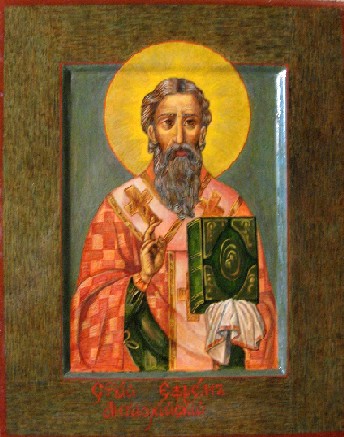 During the reign of the Byzantine Emperor Anastasius, Ephraim was governor of the eastern regions. He was famed for his great piety and compassion, and was much esteemed for these virtues. When the rebuilding of Antioch, which had been destroyed by earthquake and fire, was put in hand, the Emperor ordered Ephraim to oversee the work. Ephraim performed this work with diligence and love. There was among the ordinary workers a certain bishop who had left his see for unknown reasons and was working as a labourer. Not a soul knew that the man was a bishop. One day he lay down to take a rest from the exhausting work with the other labourers, and fell asleep. Ephraim glanced at him, and saw a flaming pillar rising above the man and reaching up to heaven. Amazed and frightened, Ephraim summoned him and bound him under oath to reveal who he was. The man hesitated a long time, but finally admitted that he was a bishop and foretold that Ephraim would shortly be consecrated Patriarch of Antioch (the patriarchal throne having been empty since the old Patriarch, Euphrasius, perished in the earthquake). Ephraim was indeed elected and consecrated as Patriarch. For his goodness, purity and zeal for Orthodoxy, a great gift of wonderworking was given him by God. Once, in order to convince some heretic that Orthodoxy is the true Faith, he placed his omophor in the flames and prayed to God. The omophor remained unharmed in the fire for three hours. When the heretic saw this, he was afraid and cast his heresy aside. Ephraim entered peacefully into rest in 546. During the reign of the Byzantine Emperor Anastasius, Ephraim was governor of the eastern regions. He was famed for his great piety and compassion, and was much esteemed for these virtues. When the rebuilding of Antioch, which had been destroyed by earthquake and fire, was put in hand, the Emperor ordered Ephraim to oversee the work. Ephraim performed this work with diligence and love. There was among the ordinary workers a certain bishop who had left his see for unknown reasons and was working as a labourer. Not a soul knew that the man was a bishop. One day he lay down to take a rest from the exhausting work with the other labourers, and fell asleep. Ephraim glanced at him, and saw a flaming pillar rising above the man and reaching up to heaven. Amazed and frightened, Ephraim summoned him and bound him under oath to reveal who he was. The man hesitated a long time, but finally admitted that he was a bishop and foretold that Ephraim would shortly be consecrated Patriarch of Antioch (the patriarchal throne having been empty since the old Patriarch, Euphrasius, perished in the earthquake). Ephraim was indeed elected and consecrated as Patriarch. For his goodness, purity and zeal for Orthodoxy, a great gift of wonderworking was given him by God. Once, in order to convince some heretic that Orthodoxy is the true Faith, he placed his omophor in the flames and prayed to God. The omophor remained unharmed in the fire for three hours. When the heretic saw this, he was afraid and cast his heresy aside. Ephraim entered peacefully into rest in 546.Our Holy Father Zossima of Phoenicia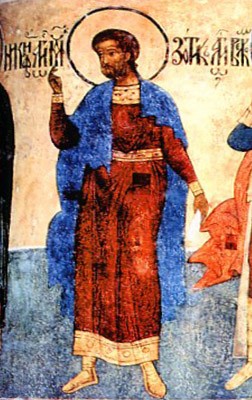 This saint was born in Synda, in the neighbourhood of Tyre, and laboured in asceticism in his monastery nearby. Having not the shadow of a cloud on his conscience, he could prophesy, see far into distant things and behold what was happening in the world. In this way he was able to witness the fall of Antioch during the earthquake, and, weeping bitterly, he prostrated himself on the ground and prayed to God that the city should not be completely destroyed. It once happened that a lion met him on a path and killed and ate his mule. The saint commanded the lion to serve him in the mule"s place, and to carry the load. The lion became as meek as a lamb, took the load upon itself and carried it to the gates of Caesarea, where Zossima gave it back its liberty and let it go. St Zossima entered peacefully into rest in the sixth century. This saint was born in Synda, in the neighbourhood of Tyre, and laboured in asceticism in his monastery nearby. Having not the shadow of a cloud on his conscience, he could prophesy, see far into distant things and behold what was happening in the world. In this way he was able to witness the fall of Antioch during the earthquake, and, weeping bitterly, he prostrated himself on the ground and prayed to God that the city should not be completely destroyed. It once happened that a lion met him on a path and killed and ate his mule. The saint commanded the lion to serve him in the mule"s place, and to carry the load. The lion became as meek as a lamb, took the load upon itself and carried it to the gates of Caesarea, where Zossima gave it back its liberty and let it go. St Zossima entered peacefully into rest in the sixth century.The Holy and Great Martyr Theodore Stratelates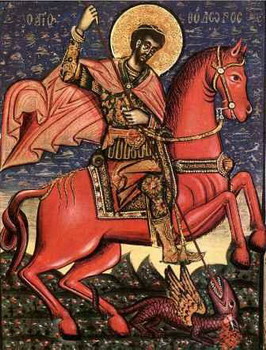 This saint is commemorated on February 8th, and his life is recounted there. However, June 8th commemorates the translation of his relics from Heraklion to Euchaita. St Theodore"s last request to his servant Varus before his martyrdom was: "Bury my body on the estate of my ancestors at Euchaita." St Anastasius of Mount Sinai has recorded the following miracle by an icon of St Theodore: At a place called Karsat, close to Damascus, there was a church dedicated to St Theodore. When the Saracens conquered Damascus, a party of them, with their wives and children, turned the church into their lodging. There was a fresco of St Theodore on the wall, and one of the Saracens let fly an arrow and struck the image of St Theodore in the face. At once blood flowed from it. Soon after that, the entire group of Saracens in that church died. St Anastasius says that he had been in that church himself, and had seen the traces of blood on the saint"s face on the wall. This saint is commemorated on February 8th, and his life is recounted there. However, June 8th commemorates the translation of his relics from Heraklion to Euchaita. St Theodore"s last request to his servant Varus before his martyrdom was: "Bury my body on the estate of my ancestors at Euchaita." St Anastasius of Mount Sinai has recorded the following miracle by an icon of St Theodore: At a place called Karsat, close to Damascus, there was a church dedicated to St Theodore. When the Saracens conquered Damascus, a party of them, with their wives and children, turned the church into their lodging. There was a fresco of St Theodore on the wall, and one of the Saracens let fly an arrow and struck the image of St Theodore in the face. At once blood flowed from it. Soon after that, the entire group of Saracens in that church died. St Anastasius says that he had been in that church himself, and had seen the traces of blood on the saint"s face on the wall.Martyrs Nicander and Marcian at Dorostulum in Moesia (303)
Martyr CallopiaSt. Theodore, bishop of Rostov and Suzdal (1023)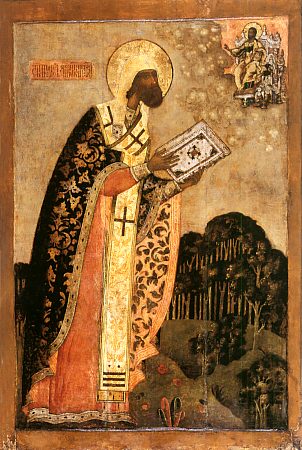 By birth a Greek, the first bishop of Rostov, he was enthroned as bishop in the year 991. At that time pagans occupied the Rostov territory and St. Theodore had much work to do to enlighten them in the Christian faith. The rough and wild pagans rendered many insults to the hierarch and once even drove him away. St. Theodore then settled in Suzdal and here enlightened many by the light of the true faith and after much apostolic labor he died in Suzdal. Not much is known about the last years of the life of St. Theodore. He died in the year 1023. His uncovered relics lie in the Suzdal Theotokos-Nativity Cathedral. By birth a Greek, the first bishop of Rostov, he was enthroned as bishop in the year 991. At that time pagans occupied the Rostov territory and St. Theodore had much work to do to enlighten them in the Christian faith. The rough and wild pagans rendered many insults to the hierarch and once even drove him away. St. Theodore then settled in Suzdal and here enlightened many by the light of the true faith and after much apostolic labor he died in Suzdal. Not much is known about the last years of the life of St. Theodore. He died in the year 1023. His uncovered relics lie in the Suzdal Theotokos-Nativity Cathedral.Martyr Nicander
Martyr Mark
Venerable Naucratius, abbot of the Studion (848)The Monk Naukratios, a student of the Monk Theodore the Studite (Comm. 11 November), because of his devotion to Orthodoxy and veneration of holy icons, was subjected to persecution by the iconoclasts. After the condemnation of the Iconoclast heresy he returned from exile and was made hegumen of the Studite monastery. he died in 848.
New Martyr Theophanes at Constantinople (1559)In his youth he was enticed into Islam, but he soon repented and accepted monasticism. Wishing to redeem his denial through blood, he, when he was in Constantinople, confessed himself a Christian. For that reason the Turks seized him and after the cruelest torture they burnt him on bed of iron spikes (iron lattice), in the year 1559.
Venerable Melania the Elder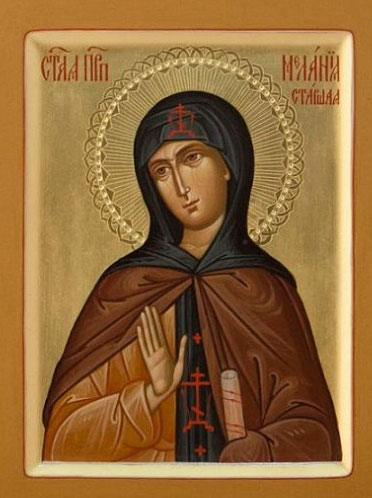 The Nun Melania was by birth the grandmother of Saint Melania the Roman (+ 431, Comm. 31 December). The Nun Melania was by birth the grandmother of Saint Melania the Roman (+ 431, Comm. 31 December).Venerable Atre (Athre) of NitriaThe Monk Aphre was a student of the Monk Horus of Nitreia (+ c. 390, Comm. 7 August). He pursued asceticism in Egypt, and died during the V Century.
Holy Hieromartyr Tevdore of Kvelta (1609)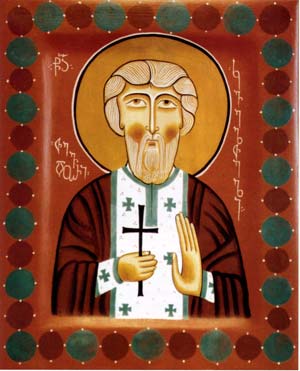 Saint Tevdore was a simple priest who labored in the 16th century in the village of Kvelta. At that time the Ottoman Empire and Persia were locked in a bitter feud over control of the Near East. At the beginning of 1609 the Ottomans conquered first the city of Baghdadi, then part of Samtskhe in southern Georgia. In June of that year they launched an attack on eastern Georgia... Saint Tevdore was a simple priest who labored in the 16th century in the village of Kvelta. At that time the Ottoman Empire and Persia were locked in a bitter feud over control of the Near East. At the beginning of 1609 the Ottomans conquered first the city of Baghdadi, then part of Samtskhe in southern Georgia. In June of that year they launched an attack on eastern Georgia... |